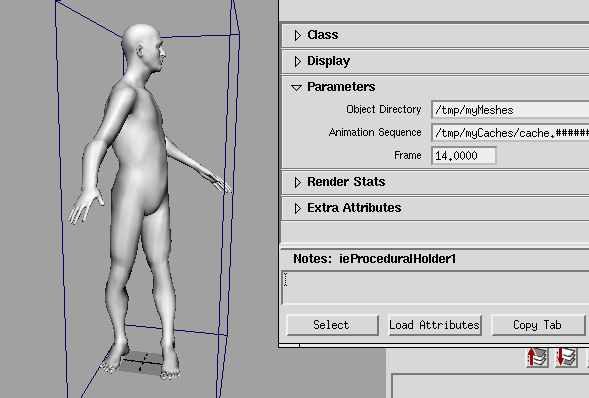-
Notifications
You must be signed in to change notification settings - Fork 124
ExamplesProceduralsAnimatedMesh
Ben Toogood edited this page Jun 13, 2013
·
2 revisions
This example pulls together the ExamplesMayaMeshExport and the ExamplesMayaVertCache by using the resulting files to render animation from within a procedural.
This code implements the procedural. It should be saved in a file called vertCacheProcedural.py.
from __future__ import with_statement
import os
import glob
import IECore
class vertCacheProcedural( IECore.ParameterisedProcedural ) :
## In the constructor we add all the parameters which define how this procedural works.
def __init__( self ) :
IECore.ParameterisedProcedural.__init__( self, "Renders cob files with vertex cached animation." )
self.parameters().addParameters(
[
IECore.DirNameParameter(
name = "objectDirectory",
description = "A directory holding the objects to be rendered.",
defaultValue = "",
allowEmptyString = True,
check = IECore.DirNameParameter.CheckType.MustExist,
),
IECore.FileSequenceParameter(
name = "animationSequence",
description = "A file sequence of animation caches to be applied. "
"Use # characters to specify the frame number.",
defaultValue = "",
allowEmptyString = True,
),
IECore.FloatParameter(
name = "frame",
description = "The frame number of the cache to render.",
defaultValue = 1,
userData = IECore.CompoundObject( {
"maya" : {
"defaultConnection" : IECore.StringData( "time1.outTime" ),
},
} ),
),
]
)
self.__lastAnimationCache = None
self.__lastAnimationSequence = ""
# This method must be implemented to return the bounding box of everything that
# will be rendered. The idea is that this method should be fast, so that if the
# bounding box isn't seen by the camera, the renderer can quickly discard the procedural
# without expanding it. Even if the bounding box is on screen, the renderer can still
# delay opening it till the last minute
def doBound( self, args ) :
animationCache = self.__animationCache( args )
result = IECore.Box3f()
files = self.__fileNames( args )
for f in files :
objectBound = None
if animationCache :
objName = os.path.splitext( os.path.split( f )[1] )[0]
try :
objectBound = animationCache.read( args["frame"].value, objName, "vertCache.boundingBox" ).value
except :
IECore.msg( IECore.Msg.Level.Error, "vertCacheProcedural::doBound", "Cache contains no bound for object \"%s\"." % objName )
else :
o = self.__loadFile( f )
objectBound = o.bound()
if objectBound :
result.extendBy( objectBound )
return result
# This method can be used to set renderer attributes outside of the procedural.
# This can sometimes be necessary to let the renderer know when it needs to
# open the procedural - for instance it might set raytrace visibility attributes.
def doRenderState( self, renderer, args ) :
pass
# This method is called when the renderer wants to know what exists inside the
# bounding box returned by doBound. Here we load the geometry, deform it, and
# pass it to the renderer.
def doRender( self, renderer, args ) :
animationCache = self.__animationCache( args )
files = self.__fileNames( args )
for f in files :
objName = os.path.splitext( os.path.split( f )[1] )[0]
o = self.__loadFile( f )
if animationCache :
p = None
try :
p = animationCache.read( args["frame"].value, objName, "vertCache.P" )
except :
IECore.msg( IECore.Msg.Level.Error, "vertCacheProcedural::doRender", "Cache contains no points for object \"%s\"." % objName )
if p :
if len( p )==o.variableSize( IECore.PrimitiveVariable.Interpolation.Vertex ) :
o["P"] = IECore.PrimitiveVariable( IECore.PrimitiveVariable.Interpolation.Vertex, p )
if o.isInstanceOf( IECore.MeshPrimitive.staticTypeId() ) and o.interpolation=="linear" and "N" in o :
IECore.MeshNormalsOp()( copyInput=False, input=o )
else :
IECore.msg( IECore.Msg.Level.Error, "vertCacheProcedural::doRender", "Vertex cache for object \"%s\" has wrong number of points" % objName )
with IECore.AttributeBlock( renderer ) :
renderer.setAttribute( "name", IECore.StringData( objName ) )
o.render( renderer )
def __fileNames( self, args ) :
return glob.glob( args["objectDirectory"].value + "/*.cob" )
def __loadFile( self, fileName ) :
# By using a CachedReader to load a file we reduce network overhead when
# the same file must be loaded repeatedly. This helps boost interactivity
# in maya.
return IECore.CachedReader.defaultCachedReader().read( fileName )
def __animationCache( self, args ) :
sequence = args["animationSequence"].value
if sequence=="" :
return None
if sequence==self.__lastAnimationSequence :
return self.__lastAnimationCache
self.__lastAnimationCache = IECore.InterpolatedCache( sequence, IECore.InterpolatedCache.Interpolation.Linear, IECore.OversamplesCalculator( 24.0, 1 ) )
return self.__lastAnimationCache
IECore.registerRunTimeTyped( vertCacheProcedural )
You can see test the procedural in maya quite easily using the following code to create a node to hold it.
execfile( "/path/to/vertCacheProcedural.py" )
import IECoreMaya
import maya.cmds
p = maya.cmds.createNode( "ieProceduralHolder" )
fp = IECoreMaya.FnProceduralHolder( "ieProceduralHolder1" )
fp.setParameterised( vertCacheProcedural() )The Parameters section of the attribute editor then allows you to specify the meshes and caches you want to render. Here we're using the meshes and caches exported by the MeshExportExample and AnimationExportExample.

- Introduction
- General Functionality
- Data Handling
- Parameters and Ops
- Point Primitives
- Mesh Primitives
- Image Primitives
- Procedurals
- Cortex & Python
- Cortex & Maya
- Cortex & Houdini